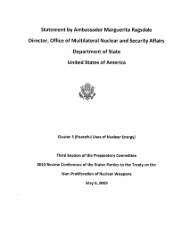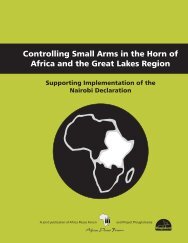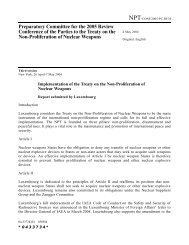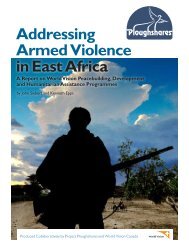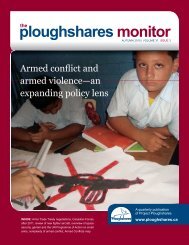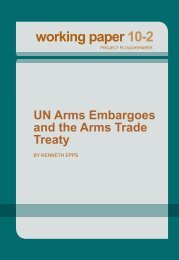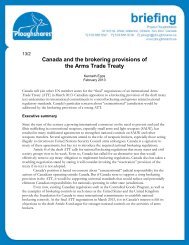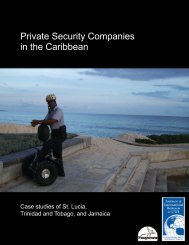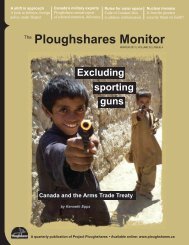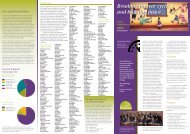Winter 2010 - Project Ploughshares
Winter 2010 - Project Ploughshares
Winter 2010 - Project Ploughshares
Create successful ePaper yourself
Turn your PDF publications into a flip-book with our unique Google optimized e-Paper software.
From START to zeroThe importance – and limitations –of the New Strategic Arms Reduction TreatyCesar Jaramillo18The New Strategic Arms Reduction Treaty (New START),signed by US President Obama and Russian PresidentMedvedev in April <strong>2010</strong> but not yet ratified, furtherreduces the strategic nuclear arms limits of previousbilateral treaties and institutes a more robust verificationregime. While the provisions of this treaty fostermuch needed transparency between the United States andRussia, it is far from a definitive step toward completenuclear disarmament. Not only does New START continueto recognize nuclear deterrence as a legitimate securitydoctrine, but the numbers of strategic nuclear weaponsstill allowed dwarf those of any other country and continueto constitute a clear and present threat to global security.BackgroundAs the Cold War was drawing to an end in the late 1980s,the United States and Russia engaged in a series of negotiationsto reduce and limit their nuclear arsenals, culminatingin the signing of the Strategic Arms Reductions Treaty(START) in 1991 and its subsequent ratification in 1994.Unlike previous arms control agreements between the twoCold War superpowers such as the 1972 Strategic ArmsLimitation treaty (SALT), which only restricted the futureproduction of new delivery vehicles, START provided forthe reduction of existing deployed warheads.START allowed the US and the Soviet Union (subsequentlyRussia) to each deploy up to 6,000 nuclearwarheads and 1,600 delivery vehicles (such as bombersand land- and submarine-based ballistic missiles).Any deployed weapons in excess of these numbershad to be taken off deployment as part of the treaty’simplementation.Besides the obvious benefit of significantly restrictingthe number of warheads, START contained a robust verificationprotocol to ensure compliance with the treaty. Thisfostered an unprecedented climate of increased transparencyand relative predictability with regard to the nuclearweapons capabilities of the signatories. Indeed, “that treaty’sverification measures allowed for a fuller understandingof [nuclear] forces than previous agreements, and thisin turn led to increased stability and cooperation betweenthe two countries” (Union of Concerned Scientists <strong>2010</strong>c).The Treaty Between the United States of America andthe Russian Federation on Strategic Offensive Reductions(SORT), also known as the Moscow Treaty, was signedin 2002 and set a new limit for each country of 2,200deployed strategic nuclear warheads. However, SORT hasbeen the subject of much criticism for its lack of verificationprovisions to ensure that agreed-to reductions havein fact taken place. Thus, the December 2009 expirationof the 1991 START marked the end of the verification protocolsand, for the first time in more than two decades,inspection teams from the US and Russia were unableto physically verify the number and operational statusof each other’s strategic nuclear forces. This increasedthe likelihood of misunderstandings and potential frictionin what is perhaps the most sensitive of arms controlregimes. To fill this void, Obama and Medvedev signed theNew START.Key provisions of New STARTNew START sets limits on nuclear warheads and deliveryvehicles that are well below those imposed by the 1991START treaty. These limits are to be met within sevenyears of treaty ratification by Russia and the US.Specifically, the primary limits for each countryincluded in the New START treaty (Gottemoeller <strong>2010</strong>)are:• A maximum of 700 deployed intercontinental ballisticmissiles (ICBMs), deployed submarine-launched ballisticmissiles (SLBMs), and deployed nuclear-capableheavy bombers;• A maximum of 1,550 deployed nuclear warheads placedin the abovementioned delivery vehicles;• A maximum of 800 deployed and non-deployed ICBMlaunchers, SLBM launchers and nuclear-capable heavybombers.The number of warheads and delivery vehicles that eachcountry is permitted to possess under this treaty, whilestill significant, is considerably lower than what wasallowed under previous bilateral treaties. Indeed, the limiton warheads is approximately 75 per cent lower than thatof START (from 6,000 to 1,550 warheads) and about 30per cent lower than the Moscow Treaty (from 2,200 to1,550). The limit on deployed delivery vehicles allowedunder START is cut by more than half (from 1,600 to 700).However, current levels of strategic nuclear forcesin the US and Russia are already remarkably close tothe New START levels. Although estimates vary, recentThe <strong>Ploughshares</strong> Monitor I <strong>Winter</strong> <strong>2010</strong>



